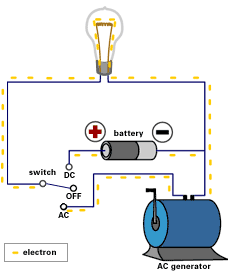※
Can you make the energy ball work? What do you think makes the ball flash & hum?
YES, we made the ball flash and hum by being part of the curcuit. We are the conductor(wires) and the ball is the resistance(light).
※
Why do you have to touch both metal contacts to make the ball work?
We become the conductor, the elctrons flow thougth in our body and that's called "current flow". We have to touch both sides to make the circuit completed.
※
Will the ball light up if you connect the contacts with any material?
No, the ball won't light up with any material except conductor.
※
Which materials will make the energy ball work?
I thick that metals could make the ball works because metals are conductor, the electrons could flow thougth it.
※
This ball does not work on certain individual. What could cause this to happen?
I think the current flow only work with people who have moisture skin. People who with dry skin can't make the electrons pass thougth their body.
※
Can you make the energy ball work with all 5-6 individuals in your group? Will it work with the entire class?
Yes, it works with any number of people, the size of the circuit will be bigger if more people become part of the circuit.

※
What kind of a circuit can you form with one energy ball?
We can form the simple circuit with on energy ball. The electrons transfer thougth our body.
Energy ball : light
Group members : conductor

※
Given two balls, can you create a circuit where both balls light up?
Yes, it's possible to create a circuit with both balls light up, the name of the circuit is series circuit.
※What do you think will happen is one person lets go of the other person's hand and why?
The current flow will stop and the ball won't light up. It just like the switch of a simple circuit, one person lets go means that the circuit is not completed, so the electrons can't flow thougth the conductor.
※Does it matter who lets go?
No, the current flow stops if anyone lets go in a simple circuit. It only matters who lets go in paralel circuit.
※Can you create a circuit where only one ball lights (both balls must be included in the circuit)?
We can create a parallel circuit to make only one ball lights. As you can see in the picture below, the electricity can still suppy to the other light bulb if one is off.
※What is the minimum number of people required to complete this?
I think one person is already possible to complete this.
Difference between series circuit and parallel circuit
Series circuit is the circuit which the loads are connected one after another in a single path. If two or more components are connected in parallel they have the same potential difference across their ends, that's parallel circuit. The difference between series circuit and parallel circuit is that a parallel circuit has more than one path in the circuit, and a series circuit only has one way around it.
For additional information, you can watch the vedio below.
 The right hand rule helps demonstrate the relationship between conductor current and the direction of force. The first right hand rule for convertional current flow is used to determine the direction of current flow in a conductor. The conductor where you right hand's thumb is pointing at, is the direction of convertional. (positive current flow).
The right hand rule helps demonstrate the relationship between conductor current and the direction of force. The first right hand rule for convertional current flow is used to determine the direction of current flow in a conductor. The conductor where you right hand's thumb is pointing at, is the direction of convertional. (positive current flow).















